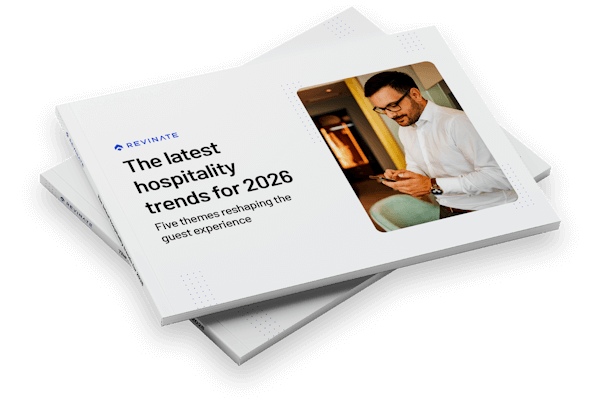The power of hotel remarketing: Bringing guests back to book
The power of hotel remarketing: Bringing guests back to book
A classic hotel remarketing challenge: Say a potential guest lands on your hotel website and spends a solid 15 minutes browsing around. They check out your rooms, compare rates, maybe even eye that premium suite. They get all the way to adding it to their cart, punch in their travel dates, and then … poof. Gone. Browser closed. Revenue vanished into thin air. If this sounds painfully familiar, you’re not alone.
Here’s the brutal truth: 98% of your website visitors leave without engaging, and cart abandonment rates have been climbing steadily, hitting 70% in 2023 and remaining there. That’s nearly three out of every four potential bookings just walking away at the finish line, taking their money with them.
Now for the good news: Hotel remarketing has become an effective weapon for battling against this frustrating scenario. A solid remarketing plan helps you connect with those interested guests and bring them back, transforming those “almost bookings” into actual reservations and real revenue.
But before we dive into strategy specifics, let’s clear up some confusion around terminology.
What is hotel remarketing?
You’ve likely heard “retargeting” and “remarketing” used interchangeably, but they’re actually different approaches leading to the same goal of bringing back interested guests.
What is retargeting?
Hotel guest retargeting uses website data to show relevant ads to people who visited your website but didn’t convert. Retargeting examples include display ads that appear when potential guests browse other websites or scroll through social media, strategically placed to remind them of their interest in your property.
What is remarketing?
Remarketing on the other hand, is the broader strategy of re-engaging with people who have already interacted with your hotel brand. Perhaps they signed up for your newsletter, previously booked, or abandoned their cart before booking. Hotel remarketing involves nurturing relationships with people who’ve given you their contact info through email campaigns, direct mail, and/or phone outreach.
Onsite vs. offsite remarketing
Your remarketing efforts can happen in two places:
- Onsite remarketing: Exit-intent pop-up offers and live chat messages that engage visitors while they’re still on your website, presenting personalized messages and offerings based on their behavior.
- Offsite remarketing: Email campaigns, retargeting ads on other platforms, and social media outreach that allow you to connect with people after they’ve left your website.
Both of these work together to create a comprehensive approach to connect with potential guests and support cart abandonment recovery.
Top benefits of hotel remarketing
Hotel remarketing should absolutely be on your radar because the benefits go way beyond just snagging those lost bookings — including real cost savings, better ROI, and happier guests.
Lower acquisition costs
One great thing about hotel guest retargeting is that it’s much less expensive than trying to find brand new customers. You’re reaching out to warm leads — people who’ve already checked out your property and shown genuine interest. That’s a huge head start. Retargeting can result in a 50% lower cost per acquisition compared to other digital advertising methods.
Increased direct-channel ROI
A well-executed remarketing campaign delivers impressive returns — with retargeting ads generating 400% ROI on average. According to our research reported in the Revinate 2025 Hospitality Benchmark Report, recurring cart abandonment campaigns are pulling in an average booking value of $1,189 and five room nights per booking.
Improved guest experience
This may surprise you, but guests actually like relevant remarketing efforts. Research shows that 60% of consumers find retargeted ads helpful because they’re personalized to their interests.
How do hotel remarketing campaigns work?
So, here’s the million-dollar question: How does this whole hotel remarketing thing actually work? The goal is to create a systematic strategy to reconnect with interested customers at the right time with the right message based on where they dropped off in your booking process.
Your campaign success depends on a few crucial considerations:
- Timing is everything. Reach out while your property is still fresh in their mind, but don’t bombard them with too much communication too soon.
- Personalization matters. Generic “come back” messages won’t cut it; reference their specific search interests, dates, or room preferences.
The beauty of remarketing campaigns is that you’ve got multiple channels to work with:
- Email campaigns. These are your bread and butter. Recurring cart abandonment emails are absolute rockstars, with our global data showing a 66.2% average open rate (OR), 21% click-through rate (CTR), and 10% conversion rate (CVR).
- Display ads. These are targeted ads that pop up on other websites customers visit, keeping your hotel top of mind.
- Social media retargeting. These ads that appear in customers’ Facebook, Instagram, or LinkedIn feeds.
- Voice channel outreach. Personal phone calls are a great way to secure high-value potential bookings.
An effective multi-channel strategy layers these different tactics together. Start with an automated email sequence and follow up with targeted ads. And for your VIP segments, consider a personal phone call. This multi-touch approach ensures that your property stays top of mind without being overwhelming.
Get started: Your ultimate hotel remarketing framework
Ready to build stronger guest relationships and turn those abandoned bookings into confirmed reservations? Here’s a step-by-step remarketing framework that you can start implementing today.
1. Determine your abandonment points
You need to start here, figuring out exactly where potential guests are dropping off. Are they leaving after browsing rooms but before starting the booking process? Or are they getting all the way to your payment page and then bailing? Use your website analytics to identify these critical abandonment points — the more specific the better — so you can create targeted remarketing campaigns for each stage.
2. Capture guest info early
It’s crucial to strategically collect contact information before guests abandon their booking. Add email capture forms early in the browsing process, not just at checkout. And don’t forget your voice channel. When agents handle calls, they should focus on capturing email addresses early in the conversation. Revinate Reservation Sales maintains an average email capture rate of over 74% for non-booked calls, giving you a treasure trove of potential guests for your retargeting campaign.
3. Establish abandoned guest segments
An advanced Customer Data Platform (CDP) allows you to segment your guest data for customized messaging, making your campaigns way more likely to convert. Our data shows that without segmentation, email open rates hover around 30%. But when you create granular segments of under 5,000 people, you’ll see a roughly 15% gain in open rates, reaching 44.9% average OR.
4. Develop an omnichannel remarketing approach
Your campaigns should hit multiple touchpoints: on-site pop-ups and chat, email sequences, social media ads, display advertising, phone calls, etc. Each channel serves a different purpose and reaches guests at different moments in their day.
5. Create high-converting remarketing copy
Your remarketing messages need to be personal, urgent, and valuable. Reference a person’s specific search details, create a sense of urgency with limited-time offers, and always include a clear call-to-action. Focus on giving potential visitors a compelling reason to come back and complete their booking.
6. Automate your remarketing strategy
Manual remarketing is a recipe for burnout. Set up automated email sequences that trigger based on specific behaviors: booking abandonment, page views, or time spent on your site. This helps ensure no guest falls through the cracks and allows you to scale your remarketing efforts without drowning your team in manual tasks.
7. Measure, test, repeat.
Track everything: open rates, click-through rates, conversion rates, and revenue generated. Test different subject lines, send times, and messaging approaches. What works for one segment may not work for another, so continuous optimization is crucial. Use these insights to refine your remarketing strategies and improve performance over time.
Hotel remarketing campaign examples
Let’s take a look at how hotel guest remarketing plays out in the real world. These remarketing examples prove that with the right strategic abandoned cart campaigns, properties can transform abandoned carts into a profitable revenue stream.
voco Melbourne Central by IHG drives 1350+ room nights
One day after cancelling a stay at voco Melbourne Central by IHG, potential guests receive a targeted email with an exclusive offer to rebook. This automated campaign consistently drives high-value returns, with 1350+ room nights booked.
Half Moon Resort achieves 70% OR and 10% CTR
Half Moon Resort in Montego Bay, Jamaica turned abandoned carts into direct revenue by launching a cart abandonment drip campaign, sending emails one minute after booking abandonment, and a second email three days later. With a 70% OR and 10% CTR, in just one year the resort booked 780+ room nights.
AutoCamp generates $110K+ in three months
Niche glamping brand AutoCamp generated $110K+ in just three months with an 11x ROI and 28% CVR — way above industry benchmarks — thanks to a cart abandonment campaign with a perfectly timed and emotionally engaging message.
Choosing a hotel remarketing solution
Now that you see what’s possible with remarketing, you’re probably thinking, “How can I make this happen at my property?” Building a killer remarketing plan requires the right technology partner who understands hospitality and delivers results from day one.
Revinate Marketing includes a comprehensive CDP and hotel email marketing platform built specifically for hospitality. It provides powerful segmentation tools for laser-focused hotel guest retargeting campaigns, automated lifecycle sequences that nurture guests from browsing to booking, and A/B testing features to fine-tune your remarketing strategies. Plus, you can maximize revenue per guest through upselling and personalized messaging.
For voice opportunities, Revinate Reservation Sales turns your team into direct booking machines, with smart agent routing, outbound selling prompts, and performance tracking. Need backup? RezForce provides on-demand, highly trained U.S.-based agents delivering 99% booking accuracy while capturing valuable leads for your remarketing pipeline.
From luxury resorts to boutique glamping sites, properties across the hospitality spectrum are using retargeting strategies to turn abandoned bookings into serious direct revenue. At the end of the day, you want more bookings and higher revenue — and that’s exactly what Revinate delivers.
Key Takeaways
- With 70% of potential guests abandoning their bookings, hotel remarketing is essential for turning lost revenue into confirmed reservations through strategic re-engagement.
- A successful remarketing strategy hits guests across multiple touchpoints at optimal times — emails, social ads, display advertising, and even phone calls — with messages that really matter to them.
- Guest segmentation boosts conversion potential: Targeted campaigns to segments under 5,000 people can achieve 44.9% open rates compared to just 30% for unsegmented campaigns.
- Hotel guest retargeting delivers impressive ROI with retargeting ads generating 400% returns on average and 50% lower acquisition costs compared to other digital advertising methods.
- Implementing a comprehensive framework — from identifying abandonment points to automating campaigns — requires hospitality-specific technology that understands the unique needs of hotels and can deliver measurable results from day one.
This site is protected by reCAPTCHA and the Google Privacy Policy and Terms of Service apply. View our Terms & Conditions here. *Required fields.






